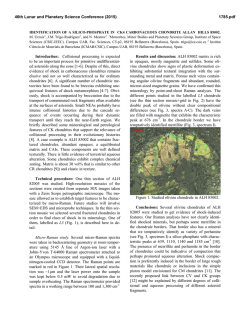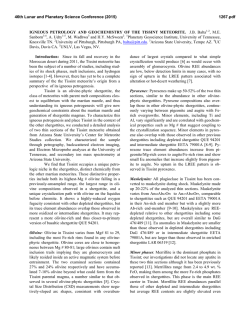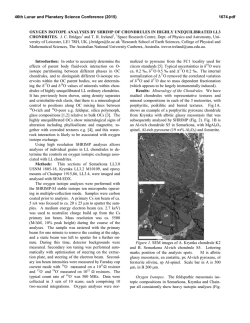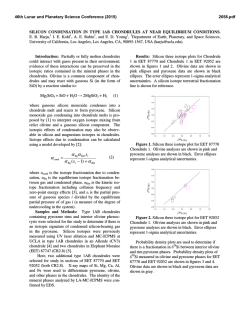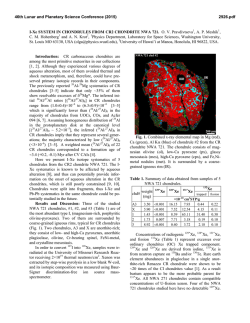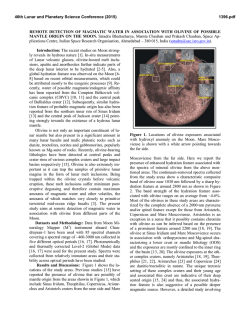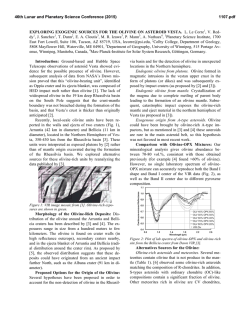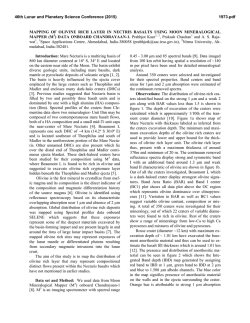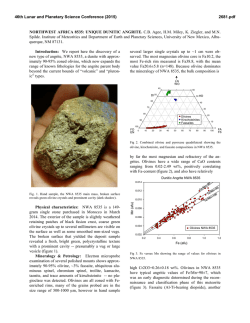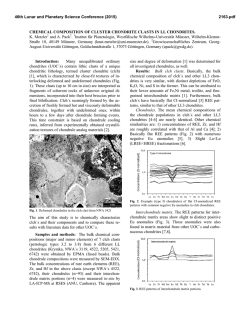
An Amoeboid Olivine Aggregate Surrounded by an Igneous Ferroan
46th Lunar and Planetary Science Conference (2015) 2477.pdf AN AMOEBOID OLIVINE AGGREGATE SURROUNDED BY AN IGNEOUS FERROAN OLIVINERICH RIM FROM CO3.0 CHONDRITE DOM 08006. K. Nagashima1, A. N. Krot1, and C. Park2. 1Hawai‘i Institute of Geophysics and Planetology, University of Hawai‘i at Mānoa, Honolulu, HI 96822, USA ([email protected]), 2Earth-System Sciences, Korea Polar Research Institute, Incheon, Korea. Introduction: We have recently described type I chondrules surrounded by ferroan igneous rims in Graves Nunataks 95229 (CR2), Yamato 81020 (CO3.0) and Acfer 094 (ungrouped type 3) carbonaceous chondrites [1,2]. The mineralogy, textures, minor element and O-isotope compositions of these layered chondrules indicate that (1) the igneous rims are similar to type II chondrules, and (2) some type I chondrules were recycled in type II chondrule-forming regions. Some of the ferroan igneous rims contain 16O-rich (Δ17O < −20‰) relict olivine grains which could be genetically related to amoeboid olivine aggregates (AOAs) that formed in the hot innermost region of the protoplanetary disk at the birth of the Solar System [e.g., 3], and were subsequently transported to chondrule-forming regions. Here we report the mineralogy, petrography, major- and minor-element abundances, and O-isotope distribution of an AOA surrounded by a ferroan igneous rim from Dominion Range (DOM) 08006 CO3.0 chondrite. Methods: The layered object #r3-1 found in a thin section of DOM 08006, 39 was studied using the UH field-emission EPMA (JEOL JXA-8500F) for mineralogy and petrography. Quantitave analysis was carried out with 10 keV acceleration voltage in order to reduce excitation volume. Oxygen-isotope distribution (δ18Oisotopograph) was obtained with the UH Isotope Microscope system (Cameca ims-1280 SIMS + SCAPS detector). Details of δ18O-isotopography are in [4]. Spatial resolution is ~1 µm. A typical error is ~8‰ (2SD). Results and Discussion: #r3-1 consists of an AOA core surrounded by a ferroan igneous rim (Fig. 1). Although the boundary between these components is very irregular, they can be easily identified in backscattered electron (BSE) images and Mg and Fe Kα x-ray elemental maps (Fig. 1a–c). The core is composed of magnesian olivine, patches of concentric layers of spinel, plagioclase, and diopside, and minor Fe,Ni-metal. Forsterite contents in most olivine grains in a center part of the core are >99 mol%. These olivines contain ~0.1–0.2 wt% CaO, ~0.05–0.2 wt% MnO, and ~0.2–0.3 wt% Cr2O3. Plagioclase is close to pure anorthite (Na2O: below detection limit; MgO < 0.06 wt%). Diopside contains variable amounts of Al2O3, ranging from ~1 to 10 wt%. These mineral compositions are consistent with those in AOAs from unmetamorphosed carbonaceous chondrites [3 and references therein]. Spinels have elevated FeO (~0.6–2 wt%) and Cr2O3 (~2 wt%). Olivine grains near the host-rim boundaries show Fe-Mg zoning and their Fo# decrease towards the rim (Figs. 1d,g). Some FeO-rich olivines occur in the core as well. The ferroan igneous rim consists of FeO-rich olivine, Fe,Ni-metal, Fe,Ni-sulfide, chromite, and glassy mesostasis, and is texturally and mineralogically similar to typical type II chondrules. FeO-rich olivines (Fo~60) are fine-grained, ranging from sub-micron to ~10 µm in size. They contain ~0.5–0.8 wt% CaO, ~0.2–0.5 wt% MnO, and ~0.05–0.4 wt% Cr2O3. These compositions are marginally consistent with those in type II chondrule olivines from CO3.0 chondrites [e.g., 5–7], but it appears that CaO is systematically higher and Cr2O3 is lower and more variable in the rim olivine. A reason for these differences is currently unknown. Glassy mesostasis contains ~1–2 wt% FeO and ~2–3 wt% Na2O. δ18O-isotopographs (Figs. 1f,i) show distinct δ18O values between the AOA host and the igneous rim. Magnesian olivines in the core have uniformly 16O-rich compositions (δ18O ~ −45‰) similar to typical AOA values [e.g., 3], while ferroan olivines in the rim have 16 O-poor compositions (δ18O ~ 0‰). The 16O-poor compositions are consistent with those in type II chondrules [8,9] and in igneous ferroan rims around type I chondrules from Y-81020 CO3.0 chondrite [2]. An Allende AOA having direct contacts of Mg-rich and Fe-rich olivines has been interpreted as a result of crystallization of ferroan olivines onto magnesian olivines of the AOA during fluid-assisted metamorphism on the CV parent asteroid [10]. The primitive nature of DOM 08006 [e.g., 7] and igneous texture of the rim of #r3-1 preclude formation of the ferroan rim olivines on a parent body. Instead, based on the mineralogy, petrography, and O-isotope compositions, we conclude the rim crystallized from a melt in an 16O-depleted reservoir under oxidizing conditions similar to those under which type II chondrules from COs formed [e.g., 9], and thus the AOA was recycled in type II chondrule-forming region. Chemical and O-isotope profiles at the core-rim boundary (Fig. 2) have step-function-like shapes with narrow boundary widths (~1–3 µm), suggesting overgrowth of ferroan rim olivines onto magnesian core olivines, crystallized from a chemically and isotopically homogeneous 16O-poor chondrule melt. The melt most likely formed by melting of dust that surrounded the AOA and possibly by dissolution of AOA olivine. The sharp O-isotope boundary observed in #r3-1 contrasts to O-isotope distribution in 16O-rich-relict-bearing olivine 46th Lunar and Planetary Science Conference (2015) 2477.pdf Fig. 1. (a–c) BSE and X-ray elemental images of AOA #r3-1 from DOM 08006 CO3.0 chondrite, consisting of AOA core and ferroan olivine igneous rim. Two regions (d,g) at the boundary between the AOA core and the rim were mapped for δ18Oisotopes (f,i). Oxygen isotopes are heterogeneously distributed: generally the core is 16O-rich and the rim is 16O-poor. cpx: diopside, Fe-ol: FeO-rich olivine, gls: glass, met: FeNi-metal, mtx: matrix, ol: MgO-rich olivine, pl: anorthite, sf: sulfide, sp: spinel. in type II chondrule from Y-81020 [11]. In this chondrule, intermediate O-isotope compositions between 16 O-rich relict core and 16O-poor edge are observed in a zone of ~30 µm, interpreted as a result of rapid quenching of chondrule melt that dissolved the relict 16O-rich olivine but avoided isotope homogenization due to an extremely fast cooling [11]. #r3-1 may have experienced a slow cooling enough to homogenize O-isotopes in the chondrule melt, possibly followed by a solid-state diffusion after crystallization of ferroan rim olivines. To estimate a possible range of cooling rates experienced by #r3-1, numerical simulation of diffusive exchanges to fit the line profiles is ongoing. References: [1] Nagashima K. et al. (2013) LPS 44:#1780. [2] Nagashima K. et al. (2014) MAPS 49(Suppl.):#5424. [3] Krot A.N. et al. (2004) Chem. Erde. 64:185-239. [4] Nagashima K. et al. (2015) GCA 151:49-67. [5] Jones R.H. (1992) GCA 56:467-482. [6] Grossman J.N. and Brearley A.J. (2005) MAPS 40:87-122. [7] Davidson J. et al. (2014) LPS 45:#1384. [8] Kunihiro T. et al. (2004) GCA 68:3599-3606. [9] Tenner T.J. et al. (2013) GCA 102:226−245. [10] Imai H. and Yurimoto H. (2003) GCA 67:765–772. [11] Yurimoto and Wasson (2002) GCA 66:4355-4363. Fig. 2. Line profiles (δ18O, Fo#, and CaO) along a red arrow in Fig. 1d, at the core-rim boundary. A typical error on δ18O is 8‰ in 2SD. Note differences in widths of chemical and Oisotopic boundaries.
© Copyright 2025
